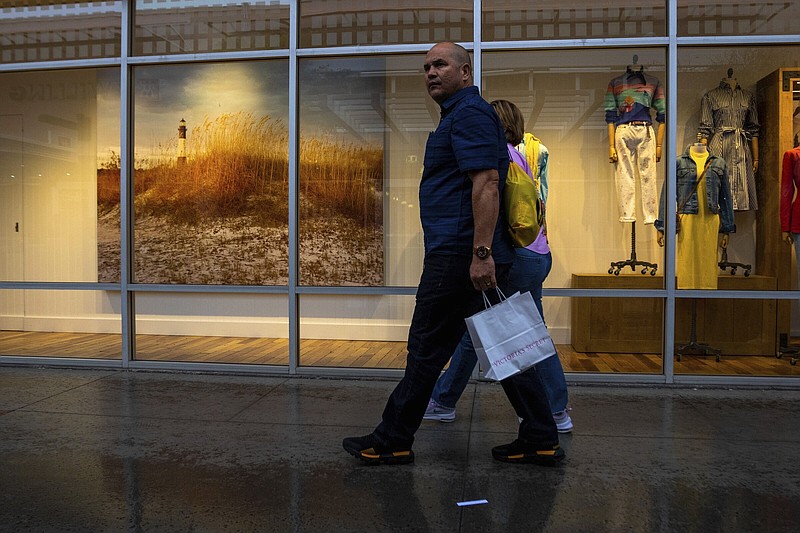Retail sales and wholesale prices in the United States declined in February, giving Federal Reserve officials more room to potentially pause interest rate increases as policymakers weigh the impact of a banking crisis against inflation risks.
American consumers trimmed retail spending in February after a buying burst in January driven by auto sales. The drop in consumer spending -- a key measure tracked by the Fed -- occurred as plummeting egg prices drove the slowdown in wholesale inflation.
The Commerce Department said Wednesday that retail sales slipped 0.4% after jumping a revised 3.2% in January. Retail sales were down in November and December, the critical holiday period.
The February retail sales figure was weighed down by a 1.8% drop in auto sales, as well as declines at restaurants and stores selling furniture and clothing. Excluding autos, sales slipped 0.1% from January, according to the Commerce Department.
Sales at furniture stores fell 2.5%, while business at restaurants declined 2.2% in February from January. Sales at department stores slid 4%. But shoppers spent more online and at electronics stores, health and beauty stores and food retailers, according to the report.
Shoppers remain relatively resilient, getting a boost from a strong job market. America's employers added a solid 311,000 jobs in February, fewer than January's huge gain. But they still are grappling with high prices on almost everything.
The drop in spending comes amid a slight drop in prices paid by consumers. The Labor Department reported Tuesday consumer price increases increased 0.4% last month, just below January's 0.5% rise.
The retail sales report comes as retailers including Walmart, Target, Home Depot and Macy's issued already cautious annual outlooks last month that pointed to a slowdown in consumer spending, particularly in clothing and furniture, as shoppers contend with higher prices, as well as rising interest rates that boost borrowing costs.
"While the supply chain issues have largely abated, prices are still high, and there is considerable pressure on the consumer," said Walmart's Chief Financial Officer John David Rainey on the call last month.
Claire Tassin, retail and e-commerce analyst at Morning Consult, a survey research technology company, noted the longer-term trend shows that retail growth is bolstered by inflation, and shoppers are pulling back on discretionary spending with the strongest impacts on department stores and home furnishings retailers.
"Essentials take priority in consumers' budgets," she added.
The retail report released Wednesday covers only about a third of overall consumer spending and doesn't include services such as hotel stays and plane tickets, which have rebounded as the threat of covid-19 eases.
WHOLESALE
U.S. producer prices unexpectedly declined in February, pointing to an easing of cost pressures in corners of an economy still battling the highest inflation in a generation.
The Labor Department said Wednesday its producer price index fell 0.1% last month, after a 0.3% rise in January. Compared with a year ago, wholesale prices rose 4.6% last month, a big drop from the 5.7% annual increase in January.
The decline reflected decreases in goods and services. That said, more than 80% of the retreat in merchandise can be attributed to a 36% drop in egg prices last month, the agency said.
Overall, wholesale prices have slowed significantly on a year-over-year basis amid improving supply chains and declines in many commodities. Producer prices excluding food, energy, and trade services -- which strips out the most volatile components of the index -- increased 0.2% last month after a revised 0.5% gain in January.
The wholesale report showed food prices declined for a third month. Energy prices edged lower. Excluding the food and energy components, final demand for goods increased 0.3%.
When paired with Tuesday's consumer price data and turmoil in the banking sector, the wholesale data presents a tricky picture for Fed officials as they decide next week whether to extend interest rate increases or retreat in an effort to buoy the banking sector.
Several categories from the wholesale report, notably in health care, are also used to calculate the personal consumption expenditures price gauge -- the Fed's preferred inflation measure -- that will be released later this month.
Fed Chair Jerome Powell had flagged the producer price index as a key indicator ahead of next week's rate-setting meeting. Powell had floated the possibility of speeding up the pace of rate increases before the unraveling of Silicon Valley Bank last week triggered worldwide concerns about the stability of the banking sector.
Credit Suisse Group AG ignited a global market rout Wednesday after its biggest shareholder ruled out investing more in the banking giant. Swaps traders now put roughly 50-50 odds on either a pause next week or a quarter-point increase by the Fed.
"U.S. data shows soft producer price inflation and retail sales, which gives the market further excuse to push in the direction of a no change Fed decision next week," James Knightley, chief international economist at ING, said in a note.
"Coupled with an inevitable tightening of lending conditions given recent events, the need for extra hikes is doubtful," Knightley wrote.
The Fed began aggressively raising interest rates a year ago, bringing the target on its benchmark rate to a range of 4.5% to 4.75%.
Information for this article was contributed by Anne D'Innocenzio and Chris Rugaber of The Associated Press; and Reade Pickert, Augusta Saraiva and Chris Middleton of Bloomberg News (WPNS)
